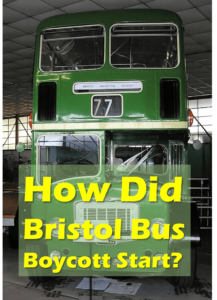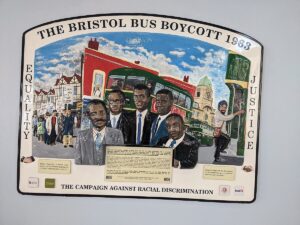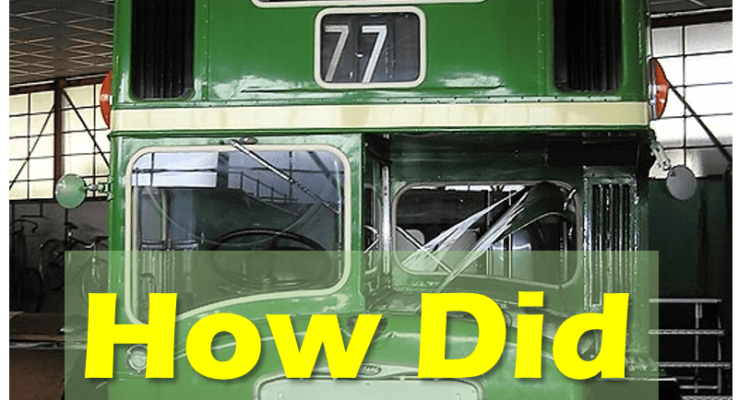How Did Bristol Bus Boycott Start?
The Windrush generation was a term used to describe the mass migration of people invited from the Caribbean colonies into Great Britain, just after the Second World War. They faced racial discrimination and hostility in many aspects of life, including housing, employment and education.

One example of this discrimination was the policy of the Bristol Omnibus Company and its workers’ union to ban ‘[racial slur] black’ people from working as bus conductors and drivers in 1955. Even though there was numerous posters and adverts looking for people to work as bus conductors and drivers in Bristol. The company manager Ian Patey defended this policy by saying that his staff were not willing to work with ‘[racial slur] black labour’ and that the quality of Bristol’s Black workers was too low for the front-line jobs. He also argued that it was unsuitable for white bus conductresses to work with Black male drivers.
What Sparked The Bristol Bus Boycott of 1963?
It was the outcome of the Bristol Bus Company’s discriminatory discrimination towards the black population. This racist policy was exposed by the Bristol Evening Post in 1961, but it was not until 1963 that a campaigning group emerged to oppose it. The Bristol Bus Boycott of 1963 was an important moment in the fight for racial equality. It was sparked after Guy Bailey now OBE, a black man, was refused a job interview by Bristol Omnibus Company. In response, members of the West Indian Development Council (WIDC) launched a strategic protest campaign to boycott Bristol Omnibus Company’s buses until they offered more job opportunities to Black people.
Who Started The Bristol Bus Boycott?
It was begun by a core of local Jamaicans (WIDC): Owen Henry, Roy Hackett, Audley Evans and Prince Brown. Also joined by Barbara Dettering and Guy Bailey. They organized a boycott of the buses, which lasted for four months and drew national and international attention. They were supported by many local Black and white residents, students, politicians and celebrities. The boycott began in August 1963 and quickly gained momentum, with many other people in the community joining forces to support Guy Bailey’s cause. In addition to boycotting the bus service, the activists held protests and public meetings, even getting support from prominent public figures of the time. They faced opposition from some white bus workers, racists and even some Black people who feared retaliation.
Some of the challenges they faced during the boycott were:
- They faced racial hatred, violence and discrimination from some white Bristolians, especially from Teddy Boy gangs of white youths.
- They had to endure hardship and inconvenience as they refused to use buses and walked or cycled instead.
- They had to overcome the resistance of the Bristol Omnibus Company, the local council and the Transport and General Workers’ Union, which all supported the colour bar policy.
- They had to mobilise public opinion and gain support from national politicians, church groups and the High Commissioner for Trinidad and Tobago.
The aim of the boycott was to put pressure on the company to take a stand against racial discrimination, and eventually the company began to take steps to do so. They started to recruit more Black employees, abolish the last-in-first-out rule, and allow Black employees to hold management positions.
This success demonstrated that peaceful protests and peaceful civil disobedience could create real change. It encouraged more people in Bristol to come together and fight for racial equality, inspiring many future civil rights campaigns.
What Did The Bristol Bus Boycott Achieve?
The boycott was successful in forcing the company to end its discriminatory policy and hire its first Black bus driver. The first Black bus worker after the Bristol Omnibus Company Boycott of 1963 would be Raghbir Singh, an Indian Sikh whom worked as a bus driver, appeared as the establishment’s first Person of colour bus employee. Vernon Samuels, a Jamaican whom subsequently served as Bristol City first Black transport driver, ultimately came after him. Following that, Vernon Samuels Junior, his son, rose to fame within Bristol as a film producer in addition to a director. The boycott also influenced the passing of the Race Relations Act of 1965, which made racial discrimination illegal in public places. The boycott was a watershed moment for Black Britain and a landmark in the struggle for racial equality.
What Happened After The Bristol Bus Boycott?
The Bristol Bus Boycott of 1963 set an example for other cities in Britain and the wider world. It reminded us that our actions can create social change, no matter how small they might be. It showed us that working together we can build a world where everyone is treated equally and no one is discriminated against based on their race or colour.
Sunday 30 April 2023 marks the 60th anniversary of the Bristol Bus Boycott movement which was a landmark event for British civil and legal rights. The boycott started in response to the Bristol Omnibus

Company’s refusal to hire black workers in 1963. After months of protests, the bus company backed down and the campaign paved the way for the UK’s first Race Relations Act of 1965.
Although the Bristol Bus Boycott of 1963 happened over 60 years ago, its legacy still carries on today. It continues to serve as inspiration for future civil rights campaigns and as a reminder that if we stand together, we can create positive change. The boycott was a crucial step in the fight for racial equality and a victory for civil rights activists.
Every year, social connection activists hold a number of events in Bristol and London to recognise the anniversary of the Bristol bus boycott. Even documentaries and short films have been produced about the boycott of 1963, which cleared the way for other fellow people of colour.
The boycott influenced other civil rights movements in Britain by:
- Drawing national attention to racial discrimination and inequality in Britain and challenging the myth of a utopian society.
- Inspiring other campaigns and protests against racism, such as the 1964 Smethwick election campaign, the 1965 Dagenham, Essex sewing machinists strike and the 1968 Ford Dagenham strike.
- Paving the way for the first Race Relations Act of 1965, which made racial discrimination unlawful in public places, and the Race Relations Act of 1968, which extended the provisions to employment and housing.
- Setting an example of non-violent resistance, community mobilisation and collaboration with allies across different backgrounds and sectors.
In August 1963, it was eventually compelled to end its “colour bar.” It was a significant triumph. And a living testament to all people of colour to never give up in your passion of what you believe in, no matter how small they might seem.



Congratulation!